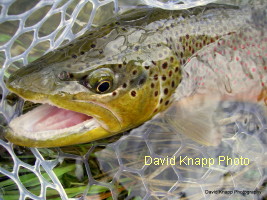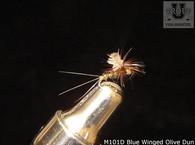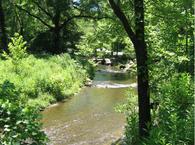
In this class you will learn what triggers a trout spawn, as how and when the spawn takes place. Although this class deals specifically with brown trout, it is similar for all types of fish.
I thought it might be appropriate to hold a class about spawning brown trout now that the spawn is occurring in the streams of Great Smoky Mountains National park and most of the other streams in the Mid-Atlantic and Southeastern United States.
Brown trout spawn when the water temperatures range between the mid forties and high forties. Of course, this water temperature must exist at the right time of the year which in the southeast is from the middle of October to the middle of December. The peak of the spawn is usually around mid November but that is subject to weather and water conditions. The brown trout spawn will usually follow the brook trout’s spawn mostly because the brook trout exist at higher elevations but also for other reasons. The timing of the spawn is also subject to water levels and the amount of light available or sunlight penetration versus darkness.
Prior to spawning, both sexes increase their intake of food. This is for two reasons. One is to provide the energy needed for the migration to their upstream spawning areas and the other has to do with producing the eggs and sperm needed for the spawn. The female carefully selects the area to spawn. She prefers to spawn on a gravel bottom. Just in case you don't know, the spawning beds of trout and salmon are called redds. With other species of fish, the spawning area will often be referred to as “beds”.
The depth of the water is important. It's normally from about 6 inches to 16 inches in depth. The depth is important because it affect light penetration and other factors. Extreme high and low water levels can affect the spawn and the survival of the eggs, the survival of the sperm as well as the very survival of the hatching trout. In the Smokies, most of the redds are found in the middle to tailends of pools, but they can be found anywhere where the type of bottom is correct, and where the water depth is correct and where the current is also correct for the spawn to take place. The effect of current can not be over emphasized as it has a great effect on the success of the spawn.
Somehow, the female knows exactly what she's looking for but, she can control these things only up to a certain extent. Mother Nature has more to do with it than she does. The female builds the redd. This is unlike a bass, for example, where the male builds the bed. She uses her swimming body motions as well the sideways movement of her tail to form a depression in the gravel. This motion results in removing the sand and silt out of the gravel where the eggs will be deposited.
While this is occurring, one or more males will complete for the right to spawn with the female. They will attempt to chase off their competition. It is not uncommon to see several males fighting for one female.
You will usually see the female swimming slowing in the redd with the male beside her during the actual spawn. She releases her eggs and he releases his milt (sperm) in the water to fertilize the eggs as they are released. She will use her tail to gently cover the eggs with gravel. This action is also thought to clean the gravel and help allow the right amount of current flow through the gravel. There can be more than one male participating during the actual spawn. She will usually release from between 4,000 to 14,000 eggs, depending on her size. It is not a well known fact, but she may not deposit all of her eggs in one redd. She may build another one in the same general area and continue the process.
The current should flow through or into the gravel but ideally, it also should create a barrier of sand and silt over the eggs and sperm. For all these reasons, it's easy to see why so few eggs survive to hatch. When the ideal conditions can't be found, or the weather and water conditions aren't right, the trout will spawn wherever and however they can.
The life of the eggs face many hazards including damage by the gravel, too much or not enough current, or simply not having the sperm find them. Many of the eggs will be eaten by other fish. In tailwaters, and some freestone stream situations, water levels can drop and expose the eggs, or the water can become real shallow and freeze. Too much silt or sand can destroy them. Of course too much water or flooding situations can destroy the entire redd. In some cases, fungus can destroy the eggs as well.
The higher the water temperature, the faster the eggs develop. In the Smokies, they usually hatch in late winter or early spring. It can be as early as February or as late as early April. Everything must remain intact until the eggs hatch and the fry can get out of the gravel in the redd and be able to swim in search of food, and of course, food must be available. Then they must be able to avoid all the predators including most fish. The mother and father or fathers are not around to help with this.
Anglers can wade through the redds and ruin the redds and the eggs. Anglers can hurt the entire operation by catching the females and/or the males. I doubt that catching the male would destroy the spawn but it could well affect the extent it was successful. It is estimated that only about ten percent of the eggs survive and that's under ideal conditions.
Please respect the spawning process and refrain from taking advantage of the ulnerability of the trout when spawning. It certainly is not sportsman like to hold up a beautiful brown trout that was caught while spawning.
View the DVD: "Discovery - The Underwater World of Trout Volume 1"
Read this informative blog: Brown Trout Spawning in the Great Smoky Mountain National Park





